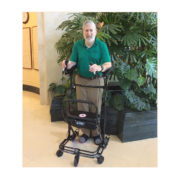Finding the Right Kind of Support
Every new day brings opportunities for people to experience the profound feeling of being valued by another person. Expressions of value differ based on circumstances. But in healthcare, when patients and clinicians come together, it is for the special purpose of improving and supporting optimal health.
We all need support. Every day, physical therapists (PTs) support people with movement difficulties due to disease, trauma, illness, developmental and acquired disabilities, and physical and emotional pain. When people have to use their arms to stand up and walk, their ability to normally and safely move is impaired. If their movement impairment is significant, then they may need more extensive upper body support.
When patients contact me, often their posture is collapsing to the point that their walker is no longer supportive enough, and walking is becoming extremely difficult. A wheelchair may seem to be their only option but they still have hope for something better. As a PT, it gives me great satisfaction to share with them a different perspective and to offer multiple options that may address their movement impairment or walking problem. After my evaluation is completed, initially much of my billable time is focused on improving my patients’ health literacy so they have a clear understanding of the resources available to help them move better, and so they can choose a treatment approach that suits them.
Bob, Carol, and I first crossed paths in the spring of 2017. Bob has Parkinson’s disease (PD) and he was having a lot of hip pain, too. Walking in his home and retirement community was becoming not only difficult but unpleasant. He was also having trouble getting in and out bed and chairs. After examining him and his home environment, and discussing with him and Carol the options available under his Medicare benefit program, he decided on a two-pronged progressive course of action: a PT-prescribed home exercise program and an upgrade from his 4-wheeled walker. So, I enrolled him in the Otago Exercise Program (OEP), which he could safely start with minimal help from Carol, and I brought a U-Step platform walker with a cueing module for him to try under my supervision.
As of the time I wrote this article, I have progressed Bob’s OEP every month or so as he has continued to make slow, steady gains in flexibility, strength, endurance and balance control. The OEP is a slowly progressive exercise program that was developed by the University of Otago in New Zealand. Developed countries around the world have adopted this program for their senior citizens as a fall risk reduction intervention. The United States adopted this program in 2012. For more information about the OEP and effective fall interventions see this informative compendium by the Centers of Disease Control and Injury Prevention.
The U-Step walker was developed by Jonathan Miller initially to assist his mother, who was struggling to walk because of PD. I have known Jonathan through phone calls and emails over 2 decades. His company, In-Step Mobility is based in Illinois. Although I’ve lived in California for more than 40 years, my roots run deep in the Mid-West where my sense of real hospitality developed. Even though I now live and work in a fast-paced technology-driven bubble called the San Francisco Bay Area, it still takes me 10 minutes to say “Hello!” and even longer to say “Goodbye!” Sometimes I feel these are hallmark signs of a disappearing era. And then I talk to the folks I know in the Mid-West who share the same hardwired appreciation for words like “Please!” and “Thank you!”, and who know how to provide really good customer service.
Because I see the personal and clinical value of the U-Step walker, I have periodically asked Jonathan if he would make platforms to attach to the U-Step walker so people with severely collapsing postures could have more equipment options to help them continue to safely walk. In 2013 the stars aligned. More people were coming to me because their arms and legs could no longer hold them up, and one of my patients, a lovely lady named Olive, agreed to be in a video to help me show Jonathan what we clinically needed to help her safely walk more upright.
Fast forward to June 2017. Bob is the first person in California to receive a U-Step platform walker. He is able to maintain his independence and can walk in his home with minimal pain with this upgraded walker system. He walks faster and he can more safely turn around so he can get in and out of the elevator in his retirement community. In addition to all the walking exercise he gets by walking to the community dining room and social events, he formally exercises 2-3 times a week by following the OEP (which includes a structured walking program). Bob and Carol’s quality of life has improved as his abilities to exercise and walk have improved.
Other reasons I value In-Step Mobility and the U-Step walker include:
- Extremely Stable: This is an important safety feature as my patients with severely collapsing postures tend to be very concerned about falling so they often try to avoid standing and walking whenever possible.
- Infinitely Adjustable: The height of the platforms and the angle of the handles can be adjusted to meet my patient’s individual ergonomic needs so they are optimally comfortable when standing and walking.
- Intuitive: The walk is intuitive to operate and requires very little physical effort for me to set it up out of the box.
- Unique Cueing Feature: The U-Step platform walker with cueing module can be set up to uniquely provide visual and/or auditory cues for my patients who need additional external input to maintain the rhythm of walking and to practice the simple-to-advanced stepping exercises I give them as homework.
- Great Customer Service: In-Step Mobility staff provide really good customer service support to patients and PTs. They kindly and patiently help people understand the criteria for Medicare to cover all or part of the cost of the U-Step walker, with or without platforms and the cueing module.
If you are a person with PD or you are having a hard time walking with your regular walker, please reach out to your local physical therapist! This licensed professional can examine you, discuss with you your exercise and equipment options, and possibly be able to help you qualify under your Medicare benefit program for an upgraded walker, like the U-Step platform walker. All 50 States in the U.S.A. now give patients the right to directly access a physical therapist without a referral from their physician, so I encourage you to call your local physical therapist. This person is there to help you find the right kind of support to keep you moving.
About Lise McCarthy: The letters after her name mean that she is a physical therapy doctor and clinical specialist in geriatric physical therapy. Her practice provides house-calls primarily to older people living in the San Francisco Bay Area in California. She very much enjoys her role as Assistant Clinical Professor, Volunteer, at the University of California at San Francisco, helping to teach the next generation of physical therapy doctors about geriatric care management standards of practice. In 2014 and with the support of many others, she became the founding Chair of the Cognitive and Mental Health Special Interest Group of the Academy of Geriatric Physical Therapy. Many consider her a national expert on care management strategies that can help people impacted by cognitive and mental health conditions improve their quality of life.






